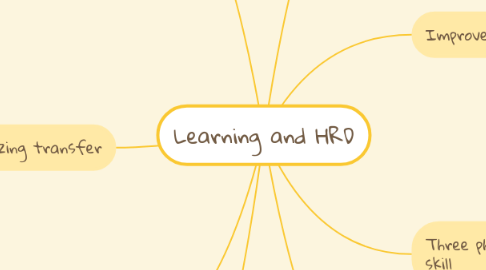
1. Maximizing learning (training)
1.1. Trainee characteristics
1.1.1. train ability
1.1.2. personality & attitudes
1.2. Training design
1.2.1. conditions of practice
1.2.1.1. active practice
1.2.1.2. overlearning
1.2.1.3. task sequencing
1.2.2. retention of what is learned
1.2.2.1. meaningfulness of the material
1.2.2.2. degree of original learning
1.2.2.3. interference
1.3. Transfer of training
1.3.1. positive transfer
1.3.2. zero transfer
1.3.3. negative transfer
2. Maximizing transfer
2.1. Identical elements
2.1.1. direct relationship to the job
2.1.2. e.g: customer service and angry customers
2.2. Physical fidelity
2.2.1. same physically & procedurally
2.2.2. e.g: flight and submarine simulators
2.3. Psychological fidelity
2.3.1. trainee experiences same stresses and conditions as he/she is being trained for
2.3.2. e.g: MS flight simulator
3. Individual differences
3.1. rate of progress
3.2. chart learning proficiency against time
3.3. charts show plateaus in learning as well as progress
4. Andragogy (M. Knowles)
4.1. adults are self-directed
4.2. adults already have knowledge & experience
4.3. adults are ready to learn relevant tasks
4.4. adults are motivated to learn
4.5. adults expect to apply learning immediately
5. Basic learning principles
5.1. Contiguity
5.1.1. things taught together become associated with each other
5.2. Law of effect
5.2.1. a behaviour followed by pleasurable experience is likely to be repeated
5.3. Practice
5.3.1. repetition increases association and knowledge
6. Improved training design
6.1. Task analysis
6.1.1. break each task down into a series of distinct component task
6.1.2. keep breaking tasks down to the simplest level possible
6.1.3. remember “K.I.S.S”
6.2. Component task achievement
6.2.1. have to specify what is to be done, under what conditions and how it is to be evaluated
6.3. Task sequencing
6.3.1. each component task should be arranged in the proper sequence
6.3.2. some are serial tasks
6.3.3. some can be done in parallel
